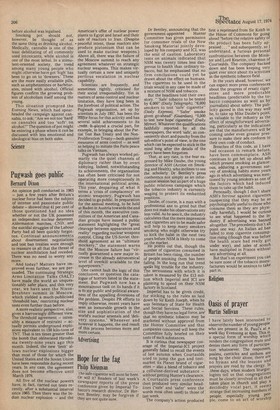Science
Pugwash goes public
Bernard Dixon
An opinion poll conducted in 1965 — just a few years after Britain's nuclear force had been the subject of intense and passionate public debate — showed that 41 per cent of those questioned had no idea whether or not the UK possessed an independent nuclear deterrent. Aldermaston marches, CND, and the suicidal struggles of the Labour Party had all been quickly forgotten. Continual announcements about disarmament negotiations and test ban treaties were enough to reassure us all that the threat of nuclear annihilation had receded. There was no need to worry any more.
And today? Matters have improved even further, we are persuaded. The continuing Strategic Arms Limitation Talks (SALT) have made the world an unquestionably safer place, and this very year, we have seen the NixonBrezhnev summit in Moscow, which yielded a much-publicised 'threshold ban,' restricting nuclear tests even further than before.
A more realistic perspective, alas, gives a harrowingly different view. The threshold agreement — ostensibly a measure of restraint — actually permits underground explosions equivalent to 150 kilo-tons of TNT. That is ten times greater than the bomb that obliterated Hiroshima twenty-nine years ago this month. Indeed, the new 'limit' allows nuclear explosions bigger than most of those for which the United States and the Soviet Union have been responsible during recent years. In any case, the agreement does not become effective until March 1976, All five of the nuclear powers have, in fact, carried out tests recently, after a substantial interval since 1965. Then there was the Indian nuclear explosion — and the American's offer of nuclear power plants to Egypt and Israel and their sale of reactors to Iran. (Despite r peaceful intent, these reactors also produce plutonium that can be used to make nuclear weapons.) Above all, there was the failure of the Moscow summit to reach any agreement whatever on strategic nuclear weapons. This makes virtually certain a new and uniquely perilous escalation in nuclear capability.
Scientists are frequently, and sometimes rightly, criticised for their social irresponsibility. Yet in matters of arms control and nuclear limitation, they have long been in the forefront of political action. The Pugwash organisation, set up by scientists in July 1957, has been the Mior focus for this activity and has several solid achievements to its credit-lt—played a crucial part, for example, in bringing about the Partial Test Ban Treaty and the NonProliferation Treaty—both genuine measures of arms control — as well as helping to initiate the Paris peace talks on Vietnam.
Pugwash has always worked primarily via the quiet channels of diplomacy rather than by overt lobbying. Indeed, notwithstanding its achievements, the organisation has often been criticised for not operating more conspicuously in the international political arena. This year, despairing of what it terms a 'crisis of complacency' on atomic weaponry, Pugwash has decided to go public. In preparation for the annual meeting, to be held at Baden in Austria towards the end of this month, the executive committees of the American and Canadian groups have issued a public statement highlighting the "great cleavage between appearances and reality" regarding nuclear weapons control. Citing the US-Soviet threshold agreement as an "ultimate mockery," the statement warns that the Moscow failure has "virtually guaranteed a new major increase in the already astronomical level of overkill available to the superpowers."
One cannot fault the logic of this conclusion, or question the catalogue of horrors listed in the statement. But Pugwash now has a mountainous task on its hands if it is to stir public and political awareness of the appalling diversions of the problem. Despite PR efforts to imply otherwise, recent years have seen an inexorable growth in the size and sophistication of the world's nuclear arsenals and 'delivery systems.' Whenever and however it happens, the end result of this process becomes more and more certain.


































 Previous page
Previous page